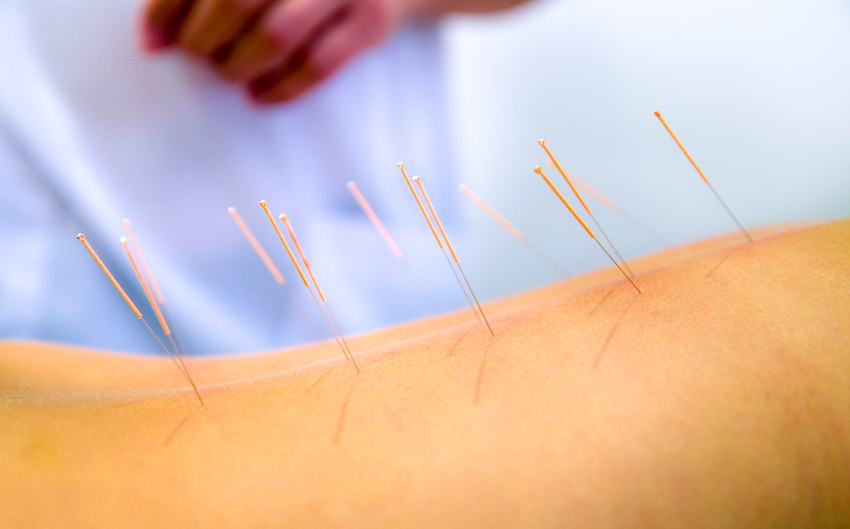Acupuncture is effective for the treatment of fibromyalgia. In one study, acupuncture demonstrated a significantly higher total effective rate for the treatment of fibromyalgia than the standard pharmaceutical therapy of amitriptyline. In another study, researchers found that acupuncture plus moxibustion produces superior treatment outcomes to tramadol and amitriptyline. Learn about acupuncture CEU continuing education and fibromyalgia at HealthCMi online.
Researchers from Heilongjiang University of Chinese Medicine determined that acupuncture had a 94.7% total effective rate for the treatment of fibromyalgia, whereas amitriptyline had a 68.4% total effective rate. In addition, relapse rates were lower in the acupuncture group than in the drug group. Six-month follow-up examinations determined that the recurrence rate for the group receiving drug therapy was 60.0%. By comparison, the group receiving acupuncture had a recurrence rate of 14.3%. [1]
A total of 38 patients were treated and evaluated in the study. They were randomly divided into two groups: an acupuncture treatment group and an amitriptyline control group, with 19 patients in each group. The treatment group patients received acupuncture, while the control group patients were administered amitriptyline.
The statistical breakdown for each randomized group was as follows. The average age in the treatment group was 50.0 ±2.9 years. The average course of disease in the treatment group was 11.0 ±2.3 months. The average number of tender points (TePsN) was 13.2 ±4.2.
The average age in the control group was 49.0 ±3.4 years. The average course of disease in the control group was 10.0 ±3.6 months. The average TePsN was 12.9 ±3.2. There were no significant statistical differences in age, course of disease, or TePsN relevant to patient outcome measures for patients initially admitted to the study. The treatment group patients received acupuncture therapy at the following acupuncture meridians:
- The Du Meridian (Governing Vessel)
- Back branches of the Bladder Meridian of Foot-Taiyang (the first and second lines lateral to the Du Meridian on the back)
Acupuncture treatment commenced with patients in a prone position. Size 0.35 mm X 40 mm disposable acupuncture needles were inserted along the meridians from top to bottom at fixed intervals to a standard depth. Once a deqi sensation was obtained, the needles were manipulated with the ping bu ping xie (mild tonifying and attenuating) technique every 10 minutes for a total of two times during the 30-minute needle retention time. One acupuncture session was administered once per day for a total of two courses, with 14 days as one course of treatment.
TCM (traditional Chinese medicine) principles document that the root cause of fibromyalgia is deficiency of the liver, spleen, and kidneys. The treatment principle is to strengthen their functions to dispel wind, coldness, dampness, and other pernicious factors. The posterior first and second lines of the bladder meridian are where the qi from zang and fu organs are accessed, and needling this meridian can strengthen the function of the liver, spleen, and kidneys. The du meridian moves yang qi within the body and governs all the yang meridians. Stimulating this meridian can strengthen yang qi to dispel pernicious factors, including those resulting in pain.
In a similar finding, Li et al. conclude that acupuncture plus moxibustion outperforms a combination of tramadol and amitriptyline. [2] One study group received acupuncture and moxibustion every two days (three days per week) for four weeks, and another received standard drug therapy of 100 mg of tramadol and 25 mg of amitriptyline orally, once per day for four weeks. Acupuncture plus moxibustion produced superior outcomes to drug therapy. The revised version of the fibromyalgia impact questionnaire (FIQR) and visual analogue scale (VAS) were used to record the results. The primary acupoints used in the study were the following:
- BL9 (Yuzhen)
- GB20 (Fengchi)
- BL11 (Dashu)
- BL16 (Dushu)
- BL17 (Geshu)
- BL18 (Ganshu)
- BL23 (Shenshu)
- BL24 (Qihaishu)
- GB21 (Jianjiing)
- SI13 (Quyuan)
- LI15 (Jianyu)
- LI10 (Shousanli)
- BL54 (Zhibian)
- GB30 (Huantiao)
- GB34 (Yanglingquan)
- ST36 (Zusanli)
For insomnia, the following acupoints were added:
- GV23 (Shangxing)
- HT7 (Shenmen)
- SP6 (Sanyinjiao)
For fatigue, the following acupoints were added:
- CV4 (Guanyuan)
- CV6 (Qihai)
For treatment, each patient was asked to rest in a prone and supine position alternatively to needle front and back acupoints. After disinfection of acupoints, 0.25 mm X 40 mm, 0.30 mm X 40 mm, or 0.30 mm X 50 mm disposable acupuncture needles were inserted into the acupoints. For Yuzhen, Fengchi, Jianjing, and Shenmen, the needles were inserted perpendicularly to a maximum depth of 25 mm. For Shangxing, the needle was inserted transversely. For Huantiao, the needle was inserted perpendicularly. For Beishu (back shu) acupoints, the needles were inserted obliquely. For other acupoints, the needles were inserted perpendicularly. After achieving deqi, the needles were manipulated with the ping bu ping xie (mild tonifying and attenuating) technique every 10 minutes during the 30-minute needle retention time.
Moxibustion treatment was administered at the back branches of the bladder meridian, du meridian, and ashi points. For the bladder and du meridians, a rectangular three-hole moxa box was used, moving from the neck to the lower back. For ashi points, a single-hole moxa box was used. The moxibustion therapy was administered until the skin became flushed. Both acupuncture and moxibustion were administered every two days (three times per week), for a total of four weeks. The outcomes were tracked for another four weeks after treatment. The researchers concluded that “acupuncture and moxibustion are safe and effective for treating fibromyalgia and present better persistent effect as compared with the combination use of orally administered tramadol and amitriptyline.”
References:
[1] Guo Y, Sun YZ. (2005). Clinical study on treatment of fibromyalgia syndrome with penetration needling at the back. Chinese Acupuncture and Moxibustion, 25(2): 98-100.
[2] Li DH, Yang L, Li J. (2016). Fibromyalgia syndrome treated with acupuncture at the acupoints of the affected meridians and heavy moxibustion at painful points: a randomized controlled trial. Chinese Acupuncture and Moxibustion, 36(2):5.



